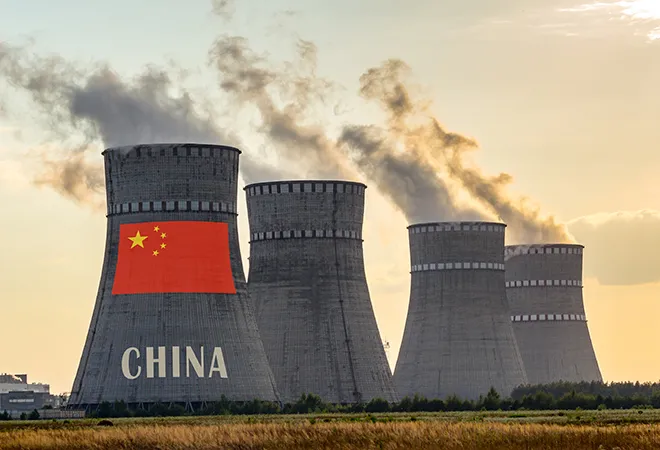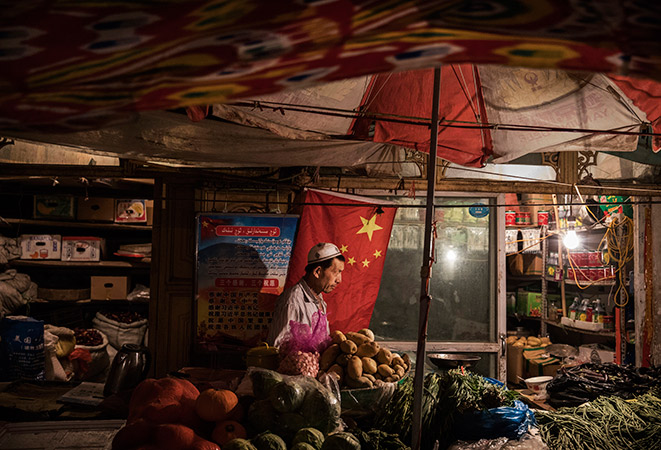
Today, China has one of the world’s largest nuclear energy development programmes. During the Cold War era, there did not exist a political or economic motivator for commercialising nuclear energy as coal-fired power stations and hydroelectric energy dominated the system. However, after 2005, China has been able to reinvent this narrative. Notably, what this resurrected was a reassertion of spaces of injustice for their minorities. Their lands were first grounds for nuclear weapons’ testing and now used for energy rather than warfare purposes, thus continuing a historical subjugation to nuclear imperialism. This nuclear imperialism situates itself within an already prevalent cyclic violence against China’s far western frontier region of Xinjiang’s ethnic minorities, the predominantly Muslim Uighurs, ever since the establishment of the People’s Republic of China (PRC) in 1949.
Given the inherent differentiation between the Uighurs and the Chinese dominant ethnicity, the Hans, the former’s identity was always up for scrutiny. The government came down particularly hard on the Uighurs after the events of 9/11 initiated the Global War on Terror (GWOT), as well as the Ürümqi riots on 5 July 2009 which saw clashes between protesting Uighurs, Han people, and China’s People’s Armed Police, leaving nearly 200 people dead in Xinjiang. The Chinese government has attributed security concerns with the certain ‘terrorist’ acts committed by a handful of them. Taking what some might perceive as an opportunist stand, China was able to claim being victim to global terrorism, to justify crackdown on the minority group. What this terrorist narrative in turn ushered in was a transnational territory of uncontrolled spaces where ‘dangerous populations’ need not be afforded legal protections and therefore be made to quarantine; containing their actions that often correspond to security threats. The antagonism was not restricted to the few Uighurs rioters. Instead the entire Uighur community as a single biological group was treated as the Homo Sacer. <1> These instances prove showcasing evidence of necropolitical <2> rule over Uighurs by the PRC, in the face of Hui or Han for instance.
Taking what some might perceive as an opportunist stand, China was able to claim being victim to global terrorism, to justify crackdown on the minority group.
China’s approach towards the Uighurs has witnessed many stages of crackdown, from a programme trying to integrate them into a Han-dominated society while cracking down on dissent, movement, practices of culture and religion, now to a virtual quarantine of the entire ethnic group by using eugenics to dilute their existence — de-Uighurise Xinjiang. The systematic discrimination of the Uighur feeds into a larger understanding of necro-politics of Uighur lives having become too consequential juxtaposed with a system which is ready to dispense with this minority population. The emphasis here is on China’s first nuclear weapons test in Lop Nor, and the legacy it has translated onto the present day context through states sponsored uranium mining in the Yili Basin, underscoring a new kind of imperialism.
Nuclear weapon testing began in the mid-1960s. Soon a kind of nuclear imperialism started to take root in the existing Han colonisation of Uighur spaces. The latter revolved around a combination of contestation over the sovereignty of the Uighur homeland and the resource-rich soils they inhabited. The aftermath of the Sino-Soviet split meant a collapse in PRCs nuclear relationship with China which acted as a driver for hastening and furthering their ambitious nuclear programmes. The PRC became the fifth nation to develop nuclear weapons during the Cold War. They formally established the 10,000 km sq. Lop Nor Nuclear Test base in 1956. It still stands as the largest site of its kind in the world.
Nuclear weapon testing began in the mid-1960s. Soon a kind of nuclear imperialism started to take root in the existing Han colonisation of Uighur spaces.
Mao Zeadong’s death in 1976 marked the end of the cultural revolution and brought in the economic liberalisation markets. Notably, the Nor test facility sustained through this transition. And the repercussions of this on the region’s Uighur population were detrimental. Environmental degradation, health-related problems, restrictions on their traditional ways are surface examples of the many hardships were made to endure. Professor Jun Takada conducted a study explaining how peak levels of radioactivity from large yield tests might have had prolonged consequences in the biological makeup of the generations to come observing congenital defects and cancer incidents in some. The cancer incidents in the region were approximately 35% higher than the rest of the state. Uighur traditional medicine could not cope with these cases. In short, a biopolitical regime protected the state from liability, meanwhile for the Uighurs, contestation around state assurance and health risks posed a blurring in the causation between sickness and exposition. The Uighurs who were affected by the Lop Nor test therefore have been given no compensation or recognition from the state. Many Hans on the other hand were given assurance from the state especially in terms of healthcare on various occasions. This only furthered the resentment and tension between the Hans and the Uighurs of Xinjiang in the years to come.
Following this, peaceful protests sprung up. In November 1985, protests led by students in Beijing against nuclear weapon tests were met with brute state coercion. In 1993, Uighurs gathered at Log Nor and demanded the ban of nuclear testing but were interrupted by PLA forces, some protestors were shot in the process. The Tigers of Lop Nor were an organisation that even managed to send tanks inside nuclear spaces and blew up planes in protest. Moreover, enveloped in this environment, the Uighur identity that already clashed with Han nationalism was simply made starker; the anti-nuclear movement began to echo separatist tendencies.
A biopolitical regime protected the state from liability, meanwhile for the Uighurs, contestation around state assurance and health risks posed a blurring in the causation between sickness and exposition.
Today, a third of the PRCs uranium for nuclear energy comes from extortion in the Yili basin of Xinjiang. This is also home to a great population of Uighurs. The PRC has placed a moratorium on the manufacturing of fissile material for deterrence purposes, transforming Xinjiang into the primary hub for the nuclear energy industry. The NINT continues to partake in nuclear research, to the north of the Lop Nor test site. There is no state system in place to ensure the safety of those dwelling the Yili. What this reflects is a revival of a past narrative of nuclear imperialism as uranium energy extraction seems to have overtaken nuclear testing. There appears to be no incentive from the ends of the government; a lacking in enforceable nuclear legislations and regional systems of monitoring and regulating nuclear activity.
In 2003, there was a law in place by China for the prevention and control of radioactive pollution coming from the development of Uranium mines. This meant that state council environmental units were delegated the responsibility to inspect this practice. However the “units” were held accountable over legitimate entities which guaranteed that any accident would have the blame falling upon a set of individuals rather than a full-fledged organisation. This left little motivation for organisations such as CNN to foresee protection of the workers. In fact, it is only when dealing with a large batch where occasional checks are made and endorsed by international agreements.
 There appears to be no incentive from the ends of the government; a lacking in enforceable nuclear legislations and regional systems of monitoring and regulating nuclear activity. Image © Kevin Frayer/Getty
There appears to be no incentive from the ends of the government; a lacking in enforceable nuclear legislations and regional systems of monitoring and regulating nuclear activity. Image © Kevin Frayer/Getty
The PRC moved towards a stronger development of uranium after 2008. China now possesses over 44 nuclear reactors in operation and 18 others under construction and is striving towards ensuring that 1/5th of their energy comes from their power plants by 2030. Activism from the minorities in the region is often counted by officials as acts of Islamism or cultural protests rather than a legacy of activities against the nuclear industry which is another layer of discrimination that has been recognised by the Uighurs. More anti-nuclear activism seems to be entering the eastern provinces of Shandong, Jiangsu, and Guangdong as a result of general community concerns against an unprotected nuclear policy. Online petitions and active media are slowly entering the scene to influence and mobilise public opinion. However, it is only perhaps a matter of time before the PRC silences them too.
Activism from the minorities in the region is often counted by officials as acts of Islamism or cultural protests rather than a legacy of activities against the nuclear industry.
Censorship is often used to subdue this kind of opposition online. What is worse is that the Uighurs of Xinjiang lack the agency to voice their grievances while practitioners in the east who are often familiar with the political systems and often well-educated are able to make negotiations with the state in terms of the relocation of nuclear power plants. Moreover, this relocation continues to happen at the expense of those lives perceived as less influential and whom the state already actively curtailing. Protected Han communities show little concern over the successor communities who not only receive the plant in their stead but also remain oblivious to the entangled intranational network whereby novel nuclear energy in the East is fueled by uranium extraction and milling in the West of the PRC.
Xinjiang, therefore, occupies the status of the core nuclear hub of the PRC who still perpetuates measures to curb challenges surrounding their Uighur minority in a bid to wipe them off completely both culturally and politically, and showcase a biopolitics of hatred and cultural genocide. Without enough mounting pressure and deft interception from the International realm, Xinjiang remains a necropolitical space where the “.. the lines between resistance and suicide, sacrifice and redemption, martyrdom and freedom are blurred.”
<1> Categories of minority may be described as Homo Sacre (“sacred” or “accursed” man), within a modern environment of biologically excluding those deemed unproductive or dangerous in modern conflicts.
<2> Necropolitics describes the utilisation of socio-political power to determine how some people may live and how some must die.
Tara Rao is a research intern at ORF.
The views expressed above belong to the author(s). ORF research and analyses now available on Telegram! Click here to access our curated content — blogs, longforms and interviews.




 There appears to be no incentive from the ends of the government; a lacking in enforceable nuclear legislations and regional systems of monitoring and regulating nuclear activity. Image © Kevin Frayer/Getty
There appears to be no incentive from the ends of the government; a lacking in enforceable nuclear legislations and regional systems of monitoring and regulating nuclear activity. Image © Kevin Frayer/Getty PREV
PREV

